Report
by Kathleen Horner
- Published: Thursday, August 15 2013 06:39

Hand Crafted Jupiter & Moons Mobile
Welcome to Astronomers Without Borders Astro Craft page for August! We will showcase Jupiter and the four moons by placing them together in a really cool hanging mobile. The big four are Io, Europa, Callisto, and Ganymede. It's an easy project and loads of fun to make and as always, educational, too. Think how great this would look in your home...it's fun to watch the little moons move about Jupiter. I've also included some Jupiter and the Galilean moons trivia in this month's article to get you inspired.
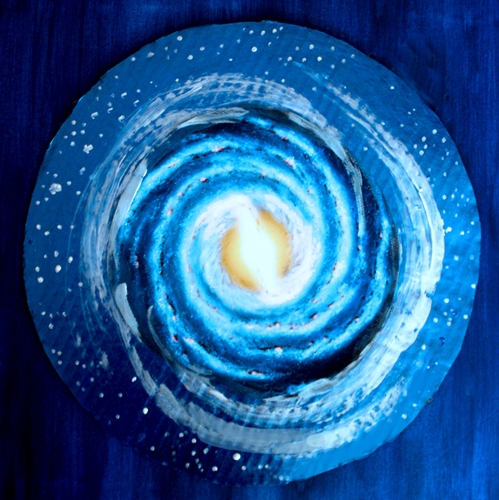
Hand Painted Hanging Mobile Disk
DIRECTIONS:
This particular hanging mobile is not difficult to create and all ages can participate. You can choose from using styrofoam balls or balloons for paper mache. I chose paper mache for Jupiter and styrofoam balls for the moons since there were no balloons available for such a small size. You will need the following material:
- 1 12" balloon or styrofoam ball (Jupiter)
- 2 1" styrofoam balls (Europa, Ganymede)
- 1 2" styrofoam ball (Io)
- 1 1/2" styrofoam ball (Callisto)
- 1 Heavy poster board or cardboard
- White tissue paper
- White flour
- Fishing line
- Small S hook
- 4 eye screws
- Ice pick
- Silver floral wire
- Tray of water
- Royal blue metallic paint
- White metallic paint
- Set of acrylic paints
- Printed copy of the Milky Way Galaxy
- Hot glue gun
- Paper glue stick
Go online and search for NASA Milky Way images (public domain and free to use for non-commercial use). Select a high resolution image and print it out on a full sheet of copy paper or photo paper. Cut in a circular shape. Choose either heavy strength poster board or cardboard and cut into a 16 inch diameter and lay out on a table. Glue the cut out Milky Way galaxy image onto the round disk. You may skip using a printed image and paint your own design on the mobile disk if you are feeling artistic. I used the printed galaxy image and painted around and blended it into the blue background. I added pearlescent-like stars with the white paint and blue metallic paint for the background. Be sure to paint or decorate both bottom and top of the disk. Use your imagination! Lay the disk down on a chopping block and make tiny holes by using an ice pick. Make one center hole for Jupiter and place the other holes closer to the outside area of the disk for the moons spacing them far enough apart for each moon's orbit. Then make three more holes near the edge of the disk spread out evenly for the fishing line to go through and hang from the ceiling. (see photo of hanging mobile above).
Blow up the large balloon to 12 inches diameter. Take the tissue paper and either cut or tear into strips. Mix flour and water until you get a loose paste-like consistency. Begin your paper mache work by dipping the tissue strips into the paste and placing onto the balloon. Create several layers of the tissue strips keeping it as smooth as possible. Leaving a little opening at the top so you can pop the balloon once its dry. After you have finished, tie a string around the top of the balloon and hang to dry. Once dry, take a pin and pop the balloon.
Go online or search astronomy magazines or books for images of Jupiter and the four Galilean moons; Io, Europa, Callisto, and Ganymede to get a good idea on colors and surface features. Select the paints you want to use and begin painting Jupiter and the moons using your own artistic license...have fun!
After you have painted Jupiter and the moons, take the eye screws and carefully screw them into the top of each styrofoam moon. Eye screws look like this:
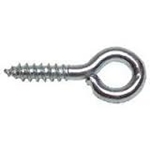
Thread fishing line through the eye screw and make a knot leaving enough line to hang from disk. Make little holes on each side of the opening of the paper mache Jupiter and thread fishing line through and make a little knot leaving enough fishing line to hang from the disk. Tie and knot fishing line on each eye screw loop and run the rest of the fishing line through the holes you made in the disk and hot glue in place. Do this also for Jupiter. You should have each moon plus Jupiter hanging from the galaxy disk. The only other thing to do is run three individual fishing line threads through the three corresponding holes that you made in the disk. Hot glue in place. Then run the three fishing line threads up and tie together and knot, hot gluing to permanently hold the knot. Take S hook and slip under the knot and attach to ceiling hook or eye screw. Voila! You have your newly created hanging mobile! (See above hanging mobile photo to get an idea of how it looks)
That's AstroCrafts for August. Stay tuned for another creative and educational craft project next month. Please feel welcomed to share your photos of this month's craft project on the Astronomers Without Borders photo gallery page. We always love hearing from AWB members. Continuing reading below on Jupiter and the Galilean moons. Lots of great Jovian trivia! Don't forget the Perseid Meteor showers this month....hope you get a chance to view them! Here's to clear skies and keep looking up!
-----
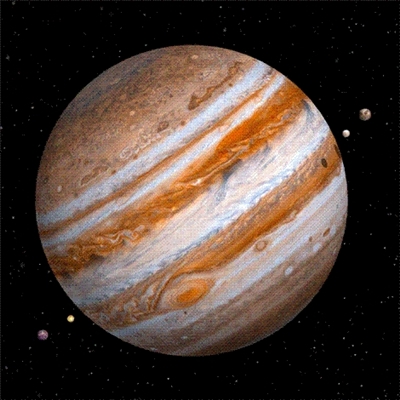
JUPITER
Jupiter is the biggest planet in our solar system with a myriad of moons (67!) and one huge magnetic field which mimics a mini solar system. In composition, Jupiter takes on the properties of a star, but somewhere along the line just didn't grow enough to ignite. All those artsy, impressionistic stripes swirling around the planet including the Great Red Spot are in reality massive storms that have raged for hundreds of years.
Jupiter and the four moons are an easy spot through a pair of 7 x 50 power or stronger binoculars. Viewing Jupiter through a telescope is even more of a delight. On the average, Jupiter is the third brightest object in the night sky after the Moon and Venus.

THE FOUR MOONS: Io, Europa, Callisto, Ganymede
Jupiter's four Moon's were discovered by Galileo Galilei in January 1610 after he had made some improvements to his telescope. Galileo named his discovery the Cosmica Sidear (Cosimo's stars). The four moons received their names from the lovers of Zeus: Io, Europa, Ganymede and Callisto. His discovery challenged common beliefs of his time with the then accepted Ptolemaic world system about the bodies of our solar system or the geocentric theory in which everything orbits around the Earth.
 Io, courtesy NASA
Io, courtesy NASA
Io is the most volcanic body (400 volcanoes) in the solar system, boasting activity 25 times that of Earth. Some of Io's volcanoes blast plumes of sulfur and other material 250 miles (400 kilometers) above the moon, which is completely resurfaced every million years or so. Io is 4.5 billion years old, about the same age as Jupiter.
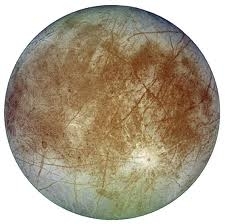 Europa, courtesy NASA
Europa, courtesy NASA
Europa is an icy moon a bit smaller than our Earth's Moon. It is thought to have an ocean of salt water which covers its entire surface. Since it is so far away from the Sun, Europa's surface is frozen over. Europa orbits Jupiter 3. 5 days and its phase is locked, just like our Moon so that the same side of Europa faces Jupiter at all times. Because the tidal forces are in constant motion, the surface is covered in cracks. The tidal heating created from this constant movement and shifting of the surface causes Europa to be warmer than it would normally be at its distance of 780,000,000 km (485,000,000 miles) from the Sun. Due to this warmth, Europa's liquid ocean may contain life if only simple organisms. In 2020, NASA and the European Space Agency are sending a mission to Jupiter and Europa. A thermal drill will be used to cut through the ice shell of Europa to begin the search for possible life in the liquid ocean beneath.
 Callisto, Courtesy NASA
Callisto, Courtesy NASA
Callisto is the outermost of the Galilean moons taking about seven of our Earth days to make a complete orbit of Jupiter. Callisto has a cratered surface with very little geologic activity and considered to be a dead world. The moon is about the same size as Mercury and is the third largest moon in the solar system.
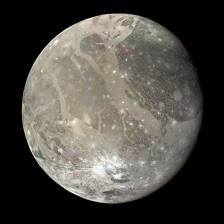 Ganymede, courtesy NASA
Ganymede, courtesy NASA
Ganymede is the largest moon in the Solar System and the third Galilean moon from Jupiter. The moon has 2 times the mass of the Earth's moon. It will have company in the future as a planned mission to Jupiter and the three Galilean moons is in the works. The European Space Agency is sending the Jupiter Icy Moon Explorer (JUICE) in the projected year of 2022. The probe will orbit around Ganymede after flybys of the three icy Galilean moons.
Exciting times ahead in space exploration! The Jovian system offers many rich features and fascinating mysteries. What we find there in the future will further our understanding of life in our Solar System and beyond.
###
My Recent Reports
Contact
| Location: | Sri Lanka  |
|---|---|
| Website: | thilinaheenatigala.blogspot.com |







Comments